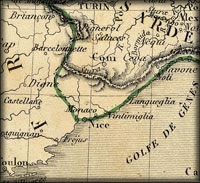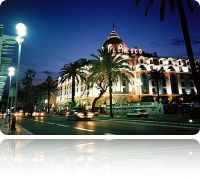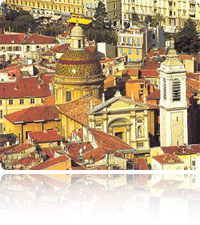About Nice
The situation
Nice, a town of 340,000 habitants, and the fifth largest in France, lies in a semi-circle, facing south, along the alluvial tracts of the pavillon, where the heights of the Alpine range come close to the sea.
Climate
The town occupies an ideal site; the Baie des Anges is well protected from the cold northerly winds and the sea moreover, exerts its moderating influence. Average temperature range from 9° in winter to 22° in summer. Only rarely does the temperature fall below 0°. Rainy days average 9° from the winter half year and 4° for the summer months.
The clear air and the sunshine are the most attractive features of the climate.
History
 The town of Nice was founded about the year 350 B.C, by a Greek colony from Marseilles, who settled on the slopes of the Chateau, which then dominated the little port of St Lambert now disused.
The town of Nice was founded about the year 350 B.C, by a Greek colony from Marseilles, who settled on the slopes of the Chateau, which then dominated the little port of St Lambert now disused.
When the Romans came in 15 B.C, they established themselves at Cimiez, on the Via Julia which linked Genoa with Aix. The roman town at Cimiez survived numerous attacks by the Barbary pirates until 1388 but finally fell to the Comte Amédée from Savoie and became the Savoyard gate to the sea via the Col de Tende. The town prospered and the Comte de Savoy fortified it to protect the new Var frontier.
The upper section of the town was completely razed to make way for the construction of a reputedly impregnable fortified castle; the lower town which grew between the Chateau and the Paillon was also fortified and surrounded by ramparts. The attacks of the Turkish fleets under Sultan Soliman in 1543 who assailed the town after combining forces with François 1 were successfully repulsed. The heroic resistance of the citizens owed much to the inspired leadership of the niçoise Catherine Segurane, who is reputed to have saved the town. But it was finally taken by Marchal Catinat in 1691 during the Augsburg war, and again in 1705 and 1706 during the Austrian Wars of Succession. The citadel was destroyed under orders of the Duc de Berwick.
 Reoccupied by the French in 1744, Nice was ceded to the house of Savoy in 1748 under the terms of the Treaty of Aix-la-Chapelle but the townsfolk demanded French citizenship in 1792; so after a brief reversion to Sardinia during the Restoration, Nice finally became French by unanimous vote in 1860.
Reoccupied by the French in 1744, Nice was ceded to the house of Savoy in 1748 under the terms of the Treaty of Aix-la-Chapelle but the townsfolk demanded French citizenship in 1792; so after a brief reversion to Sardinia during the Restoration, Nice finally became French by unanimous vote in 1860.
From that time, the town grew and prospered; in 1860 there were fewer of 45,000 inhabitants.
A century later, the population had swelled to 350,000.
Tourism
 Nice tourist trade development originated in 1850. Its easy access attracted the wealthy English aristocrats and upper classes who sought to escape from the rigours of the English winters and who possessed the means and inclination to exchange sleet and snow for sunshine and soft sea breezes on the Côte d’Azur.
Nice tourist trade development originated in 1850. Its easy access attracted the wealthy English aristocrats and upper classes who sought to escape from the rigours of the English winters and who possessed the means and inclination to exchange sleet and snow for sunshine and soft sea breezes on the Côte d’Azur.
This well-to-do English clientele was largely responsible for the growth and fame of Nice as an ideal tourist centre.
Nice was in its heyday between 1860 and 1940; during this period it became the classic rendezvous for the titled and the gentry who sought the refuge offered by the temperate climates during the winter months. Travel was greatly facilitated but the rail link which was completed in 1869.
The hotel trade flourished: the demand for accommodation was reflected by the increase of the number of hotels. There were 33 in 1861 and no less than 182 in 1910. After the 1914-18 war, the scene changed with the disappearance of many traditional visitors. The great luxury palaces became too expensive and being no longer profitable were sold. In their place were built smaller establishments offering more modest accommodation. These were sited in various parts of the town, and by 1963 represented a total of 10,000 rooms in 325 hotels, with an additional 10,000 furnished rooms available to let during the winter and summer months of the season.
Nice is the undisputed capital of the Côte d’Azur offering tourist attractions all the year round, including its famous carnival and the battle of flowers. In winter, too the are other attractions of the nearby ski station of Beuil, Auron, Greoliere, Valberg, Piera-Cava – less than 2 hours distant.
Tours of the town, place of interest
With its charm and mild climate, the discovery of monuments and historical sites in the town and the neighbouring hills is a delightful experience equalled only by the enjoyment of the mini renowned fete and entertainments which take place throughout the year. Places worth visiting include:
Promenade des Anglais: every tourist is familiar with the famous Promenade, flanking the Baie des Anges.
- Chateau
 The hill on which was constructed the fortress erected by the Comte de Savoie and destroyed by the French in 1706.
The hill on which was constructed the fortress erected by the Comte de Savoie and destroyed by the French in 1706.- The flower market
- Held on the Court Saleya from 1pm to 3pm.
- The old town
- Between the Paillon and the Chateau, this is the old Greek settlement; Its character is unmistakably Mediterranean, and there are many beautiful churches to be visited, and the 17th century cathedral of St Raparate.
- Cimiez
- the Ruins of the Arenas of the old roman part of the town still remain. There is a fifteen century wayside Cross, set on a column in front of the Franciscan church. Visit also the Jardin des Moines and the Roman baths.
- Mont Boron
- A wooded hill to the East of the town, dominating the Fort. The Mont Alban fort was built in the 1560 as part of the defence works of the town set up by the Comte de Savoie.
- Le Palais de la Méditerranée
- Casino and Théâtre of modern construction. Includes a conference and entertainments hall.
- Promenade des Ponchettes
- a terraced promenade construction in the 18 century.
- The Russian church
- built in 1905.
- The church of St Barthelemy
- has a renaissance façade.
- The church of St Joan of Arc
- a modern masterpiece.
- The port
 The port of Nice consists of the early Lympia dock, 38,000sqm, the Basin des Amiraux (Admirals dock) of 34,000 sqm, had the most recently constructed Bassin du Commerce (trading dock) which is 35,000sqm in extent. The docks include an outer harbour of 40,000 sqm and a 380s qm jetty protecting the latter and the Bassin du Commerçe. Passenger vessels run by the company SNCM and Corsica Ferries.
The port of Nice consists of the early Lympia dock, 38,000sqm, the Basin des Amiraux (Admirals dock) of 34,000 sqm, had the most recently constructed Bassin du Commerce (trading dock) which is 35,000sqm in extent. The docks include an outer harbour of 40,000 sqm and a 380s qm jetty protecting the latter and the Bassin du Commerçe. Passenger vessels run by the company SNCM and Corsica Ferries.
